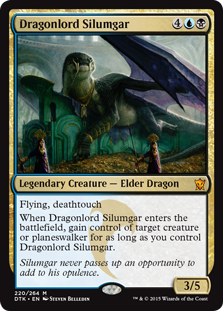1) Theme/Strategy
- Do some homework. What are the most powerful cards? What are the themes and synergies within the sets you will be drafting? If you want a strong deck, you will probably want to settle into one of these themes to get extra value from your cards. For example, WB Warriors, RG Formidable, or UB Exploit.
- Keep it simple. Usually the simpler the game plan, the better. Since you will rarely get more than 1-2 copies of a card in your deck, you can't count on drawing them every game and thus can't rely on combos to win you the game. You are probably just going to win by attacking with creatures, whether it's with a quick aggressive deck, or with a more defensive controlling deck. Cards that require really strange scenarios to be good should probably be left out of your deck.
Art from Goblin Heelcutter by Jesper Ejsing
2) B.R.E.A.D.
- Prioritize your picks in this order.
B - Bombs: These are powerful rares or uncommons that will almost always win you the game if you get a chance to play them. They have the power to end the game quickly or can pull you back from a losing position. For example, Dragonlord Silumgar or Sunscorch Regent.
R - Removal: Quite simply, you need ways to deal with your opponent's bombs. Whoever can play their bomb and keep it on the board is probably going to win. Removal spells can also give you a favorable board state for attacking (quick aggro decks) or blocking (decks stalling for their bombs).
E - Evasion: Prioritize creatures that are hard to block, such as flying or intimidate. The battlefield will tend to get clogged up with creatures and evasion can allow you to keep dealing damage without having to attack into blockers. Don't underestimate the threat of dealing 2-3 damage every turn.
A - Aggro: Most successful limited decks win with creatures. You will need lots of them. They will die in combat, die to removal, etc. and you don't want to run out before your opponent. Make sure you fill out your mana curve with lots of creatures that can deal damage to your opponent. Generally a 3/1 is better than 1/3 because it can trade with larger creatures and puts more pressure on your opponent to deal with it. It can possibly require a removal spell that would otherwise be used on your bomb.
D - Dud: This just means whatever is leftover. If there is nothing in your pack that fits the other categories then I look for two possible things here; either good sideboard cards that are very powerful in specific situations, such as Plummet or Naturalize, or I look for cards that other players might want for their decks. Maybe the pack has nothing playable for my White Green Bolster deck, but that Bathe in Dragonfire would sure be nasty in my opponent's deck. I'll take it just to keep it from being used against me.
3) Deckbuilding: 40 cards. The minimum deck size in limited is 40 cards. Don't go over that.
- 17 lands is the proven, perfect number. Don't bother trying to justify 16 or 18, just stick to 17.
- 6 best removal spells. Consider insants vs. sorceries, mana cost, and how many types of threats it can deal with. If you don't have 6 removal spells, consider substituting instant speed combat tricks that can help you take down threats when attacking or blocking.
- 17 creatures along a mana curve, which I'll talk about next.
4) Mana curve: In limited you want to be casting a spell every turn, whether it's creatures on your turn or removal on your opponent's turn. You can't afford to take turns off or you will fall behind.
- For your creatures, consider a distribution like this.
1 mana - 1-2
2 mana - 3-4
3 mana - 4-5
4 mana - 3-4
5 mana - 2
6 mana - 1-2
I won my first ever FNM draft with this deck!
5) Value: Look for cards with great value. You get great value when your card is able to trade for two or more of your opponent's cards. Examples of this are Ainok Survivalist (aggro creature with Naturalize stapled to him) and Pyrotechnics (capable of killing up to 4 creatures!).
- Patrick







No comments:
Post a Comment